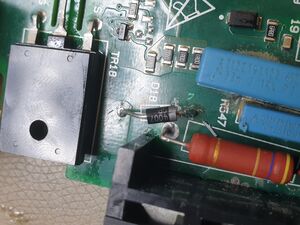No edit summary |
No edit summary |
||
| Line 22: | Line 22: | ||
==Solution== | ==Solution== | ||
Measure D18 diode in with a multimeter in diode mode. Make sure it measures 0.4-0.7V, anything less or more and it's dead. In this case it was 0.1V on both ways which indicates that it's dead. The original diode was a PR1600. A photoflash rectifier diode with 1600v reverse voltage. I've replaced it with a rectifying diode with 1kV reverse voltage and it started switching properly again and working. | Measure D18 diode in with a multimeter in diode mode. Make sure it measures 0.4-0.7V, anything less or more and it's dead. In this case it was 0.1V on both ways which indicates that it's dead. The original diode was a PR1600. A photoflash rectifier diode with 1600v reverse voltage. I've replaced it with a rectifying diode with 1kV reverse voltage and it started switching properly again and working. | ||
Latest revision as of 05:52, 15 June 2024
| Emerson SP2403 not turning on repair | |
|---|---|
| Device | Emerson SP2403 |
| Affects part(s) | D18 diode (PR 1600) |
| Needs equipment | multimeter, soldering iron, soldering station. |
| Difficulty | ◉◉◉◌ Hard |
| Type | Soldering |
Problem description
Diagnosing and fixing an issue with an Emerson SP2403 inverter that does not turn on or react to power when connected to 3 phase 400V AC
Symptoms
- Not turning on.
- Not reacting to power.
- MOSFET gate switching for split second then stopping and repeating when measured with an oscilloscope.
- VCC for UC2844B going up to 16V then dropping to 7V and raising again on a loop.
Solution
Measure D18 diode in with a multimeter in diode mode. Make sure it measures 0.4-0.7V, anything less or more and it's dead. In this case it was 0.1V on both ways which indicates that it's dead. The original diode was a PR1600. A photoflash rectifier diode with 1600v reverse voltage. I've replaced it with a rectifying diode with 1kV reverse voltage and it started switching properly again and working.
